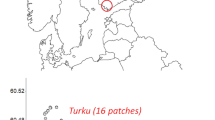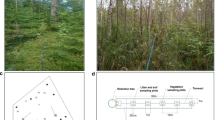Abstract
Successful persistence of dry forests depends on tree regeneration, which depends on a balance of complex biotic interactions. In particular, the relative importance and interactive effects of shrubs and herbivores on tree regeneration are unclear. In a manipulative study, we investigated if thornless shrubs have a direct net effect, an indirect positive effect mediated by livestock, and/or an indirect negative effect mediated by small vertebrates on tree regeneration of two key species of Chaco forest (Argentina). In a spatial association study, we also explored the existence of net positive interactions from thorny and thornless shrubs. The number of Schinopsis lorentzii seedlings was highest under artificial shade with native herbivores and livestock excluded. Even excluding livestock, no seedlings were found with natural conditions (native herbivores present with natural shade or direct sunlight) at the end of the experiment. Surprisingly, seedling recruitment was not enhanced under thornless shrubs, because there was a complementary positive effect of shade and interference. Moreover, thornless shrubs had neither positive nor negative effects on regeneration of S. lorentzii. Regeneration of Aspidosperma quebracho-blanco was minimal in all treatments. In agreement with the experiment, spatial distributions of saplings of both tree species were independent of thornless shrubs, but positively associated with thorny shrubs. Our results suggest that in general thornless shrubs may have a negligible effect and thorny shrubs a net positive effect on tree regeneration in dry forests. These findings provide a conceptual framework for testing the impact of biotic interactions on seedling recruitment in other dry forests.



Similar content being viewed by others
References
Alzugaray C, Carnevale NJ, Salinas AR, Pioli R (2007) Factores bioticos y abioticos que afectan la calidad de las semillas de Schinopsis balansae Engl. y Aspidosperma quebracho-blanco Schltdl. Rev Iberoam Micol 24:142–147
Anthelme F, Michalet R (2009) Grass-to-tree facilitation in an arid grazed environment (Air mountains, Sahara). Basic Appl Ecol 10:437–446. doi:10.1016/j.baae.2008.10.008
Baraza E, Zamora R, Hodar JA (2006) Conditional outcomes in plant–herbivore interactions: neighbours matter. Oikos 113:148–156. doi:10.1111/j.0030-1299.2006.14265.x
Barbosa P, Hines J, Kaplan I (2009) Associational resistance and associational susceptibility: having right or wrong neighbors. Annu Rev Ecol Evol Syst 40:1–20
Barchuk AH, Valiente-Banuet A, Diaz MP (2005) Effect of shrubs and seasonal variability of rainfall on the establishment of Aspidosperma quebracho-blanco in two edaphically contrasting environments. Austral Ecol 30:695–705. doi:10.1111/j.1442-9993.2005.01511.x
Barchuk AH, Iglesias MDR, Boetto MN (2008) Spatial association of Aspidosperma quebracho-blanco juveniles with shrubs and conspecific adults in the Arid Chaco, Argentina. Austral Ecol 33:775–783. doi:10.1111/j.1442-9993.2008.01846.x
Bates D, Maechler M, Bolker B (2012) lme4: Linear mixed-effects models using S4 classes. R package version 0.999999-0. http://CRAN.R-project.org/package=lme4
Bertness MD, Callaway R (1994) Positive interactions in communities. Trends Ecol Evol 9:191–193. doi:10.1016/0169-5347(94)90088-4
Boletta PE, Ravelo AC, Planchuelo AM, Grilli M (2006) Assessing deforestation in the Argentine Chaco. For Ecol Manag 228:108–114. doi:10.1016/j.foreco.2006.02.045
Brooker RW, Maestre FT, Callaway RM et al (2008) Facilitation in plant communities: the past, the present, and the future. J Ecol 96:18–34. doi:10.1111/j.1365-2745.2007.01295.x
Caccia FD, Chaneton EJ, Kitzberger T (2009) Direct and indirect effects of understory bamboo shape tree regeneration niches in a mixed temperate forest. Oecologia 161:771–780. doi:10.1007/s00442-009-1412-z
Callaway RM (1995) Positive interactions among plants. Bot Rev 61:306–349. doi:10.1007/bf02912621
Callaway RM, Walker LR (1997) Competition and facilitation: a synthetic approach to interactions in plant communities. Ecology 78:1958–1965. doi: 10.1890/0012-9658(1997)078[1958:cafasa]2.0.co;2
Carrillo-Garcia A, Bashan Y, Bethlenfalvay GJ (2000) Resource-island soils and the survival of the giant cactus, cardon, of Baja California Sur. Plant Soil 218:207–214. doi:10.1023/a:1014953028163
Catan A, Degano CAM (2007) Composición botánica de la dieta de caprinos en un bosque del Chaco semiárido (Argentina). Quebracho 14:15–22
Chaneton EJ, Mazia CN, Kitzberger T (2010) Facilitation vs. apparent competition: insect herbivory alters tree seedling recruitment under nurse shrubs in a steppe-woodland ecotone. J Ecol 98:488–497. doi:10.1111/j.1365-2745.2009.01631.x
Cuesta B, Villar-Salvador P, Puertolas J et al (2010) Facilitation of Quercus ilex in Mediterranean shrubland is explained by both direct and indirect interactions mediated by herbs. J Ecol 98:687–696. doi:10.1111/j.1365-2745.2010.01655.x
Dinerstein E, Olson DM, Graham DJ et al (1995) A conservation assessment of the terrestrial ecoregions of Latin America and the Caribbean. WWF–The World Bank, Washington, DC
Flores J, Jurado E (2003) Are nurse–protege interactions more common among plants from arid environments? J Veg Sci 14:911–916. doi:10.1111/j.1654-1103.2003.tb02225.x
Gasparri NI, Grau HR (2009) Deforestation and fragmentation of Chaco dry forest in NW Argentina (1972–2007). For Ecol Manag 258:913–921. doi:10.1016/j.foreco.2009.02.024
Gomez-Aparicio L, Zamora R, Castro J, Hodar JA (2008) Facilitation of tree saplings by nurse plants: microhabitat amelioration or protection against herbivores? J Veg Sci 19:161–172. doi:10.3170/2007-8-18347
Graff P, Aguiar MR (2011) Testing the role of biotic stress in the stress gradient hypothesis. Processes and patterns in arid rangelands. Oikos 120:1023–1030. doi:10.1111/j.1600-0706.2010.19059.x
Graff P, Aguiar MR, Chaneton EJ (2007) Shifts in positive and negative plant interactions along a grazing intensity gradient. Ecology 88:188–199. doi:10.1890/0012-9658(2007)88[188:sipanp]2.0.co;2
Harper JL (1977) Population biology of plants. Academic, London
Holmgren M, Scheffer M, Huston MA (1997) The interplay of facilitation and competition in plant communities. Ecology 78:1966–1975. doi:10.1890/0012-9658(1997)078[1966:TIOFAC]2.0.CO;2
Holt RD (1984) Spatial heterogeneity, indirect interactions, and the coexistence of prey species. Am Nat 124:377–406. doi:10.1086/284280
Jensen AM, Lof M, Gardiner ES (2011) Effects of above- and below-ground competition from shrubs on photosynthesis, transpiration and growth in Quercus robur L. seedlings. Environ Exp Bot 71:367–375. doi:10.1016/j.envexpbot.2011.02.005
Kitajima K, Fenner M (2000) Ecology of seedling regeneration. CABI, Wallingford
Maestre FT, Bautista S, Cortina J (2003) Positive, negative, and net effects in grass–shrub interactions in mediterranean semiarid grasslands. Ecology 84:3186–3197. doi:10.1890/02-0635
Maestre FT, Callaway RM, Valladares F, Lortie CJ (2009) Refining the stress-gradient hypothesis for competition and facilitation in plant communities. J Ecol 97:199–205. doi:10.1111/j.1365-2745.2008.01476.x
McAuliffe JR (1984) Sahuaro-nurse tree associations in the Sonoran Desert: competitive effects of sahuaros. Oecologia 64:319–321. doi:10.1007/bf00379128
McAuliffe JR (1986) Herbivore-limited establishment of a sonoran desert tree, Cercidium microphyllum. Ecology 67:276–280. doi:10.2307/1938533
Michalet R (2006) Is facilitation in arid environments the result of direct or complex interactions? Commentary. New Phytol 169:3–6. doi:10.1111/j.1468-8137.2006.01617.x
Orrock JL, Holt RD, Baskett ML (2010) Refuge-mediated apparent competition in plant–consumer interactions. Ecol Lett 13:11–20. doi:10.1111/j.1461-0248.2009.01412.x
Paez SA, Marco DE (2000) Seedling habitat structure in dry Chaco forest (Argentina). J Arid Environ 46:57–68. doi:10.1006/jare.2000.0648
Peguero G, Lanuza OR, Save R, Espelta JM (2012) Allelopathic potential of the neotropical dry-forest tree Acacia pennatula Benth: inhibition of seedling establishment exceeds facilitation under tree canopies. Plant Ecol 213:1945–1953. doi:10.1007/s11258-011-0014-0
Perry JN (1998) Measures of spatial pattern for counts. Ecology 79:1008–1017. doi:10.1890/0012-9658(1998)079[1008:mospfc]2.0.co;2
Perry JN, Bell ED, Smith RH, Woiwod IP (1996) SADIE: software to measure and model spatial pattern. Asp Appl Biol 46:95–102
Perry JN, Winder L, Holland JM, Alston RD (1999) Red–blue plots for detecting clusters in count data. Ecol Lett 2:106–113. doi:10.1046/j.1461-0248.1999.22057.x
Portillo-Quintero CA, Sanchez-Azofeifa GA (2010) Extent and conservation of tropical dry forests in the Americas. Biol Conserv 143:144–155. doi:10.1016/j.biocon.2009.09.020
Prado DE (1993) What is the Gran Chaco vegetation in South America? I. A review: contribution to the study of flora and vegetation of the Chaco, V. Candollea 48:145–172
Prevosto B, Monnier Y, Ripert C, Fernandez C (2012) To what extent do time, species identity and selected plant response variables influence woody plant interactions? J Appl Ecol 49:1344–1355. doi:10.1111/jpe.12000
R Development Core Team (2012) R: a language and environment for statistical computing, Vienna. http://www.r-project.org
Ridenour WM, Callaway RM (2001) The relative importance of allelopathy in interference: the effects of an invasive weed on a native bunchgrass. Oecologia 126:444–450. doi:10.1007/s004420000533
Seghezzo L, Volante JN, Paruelo JM et al (2011) Native forests and agriculture in Salta (Argentina): conflicting visions of development. J Environ Dev 20:251–277. doi:10.1177/1070496511416915
Smit C, Den Ouden JAN, Muller-Scharer H (2006) Unpalatable plants facilitate tree sapling survival in wooded pastures. J Appl Ecol 43:305–312. doi:10.1111/j.1365-2664.2006.01147.x
Tálamo A, Caziani SM (2003) Variation in woody vegetation among sites with different disturbance histories in the Argentine Chaco. For Ecol Manag 184:79–92. doi:10.1016/s0378-1127(03)00150-6
Zuur FL, Ieno AF, Walker NJ et al (2009) Mixed effects models and extensions in ecology with R. Springer, New York
Acknowledgments
This paper was made possible due to the support of the Consejo de Investigación de la Universidad Nacional de Salta (CIUNSa), Consejo Nacional de Investigaciones Científicas y Técnicas (CONICET) and to the grants provided by The Rufford Small Grant Foundation. We also would like to thank the National Parks Administration, which allowed us to conduct our research. Feedback from P. Graff, T. Kitzberger, K. Clark and L. Branch on an early version of this work and comments from J. Armesto, Katherine Gross and two anonymous reviewers greatly improved the manuscript. Finally, we would like to thank E. Tordoya, C. Yáñez, A. Gorosito and Y. Bonduri for field assistance and to C. Moraga, K. Clark, L. Branch, D.L. Miller and M. Thetford for English translation of the manuscript. The experiments comply with the current laws of Argentina in which the experiments were performed.
Author information
Authors and Affiliations
Corresponding author
Additional information
Communicated by Juan J Armesto.
Electronic supplementary material
Below is the link to the electronic supplementary material.
Rights and permissions
About this article
Cite this article
Tálamo, A., Barchuk, A.H., Garibaldi, L.A. et al. Disentangling the effects of shrubs and herbivores on tree regeneration in a dry Chaco forest (Argentina). Oecologia 178, 847–854 (2015). https://doi.org/10.1007/s00442-015-3269-7
Received:
Accepted:
Published:
Issue Date:
DOI: https://doi.org/10.1007/s00442-015-3269-7




